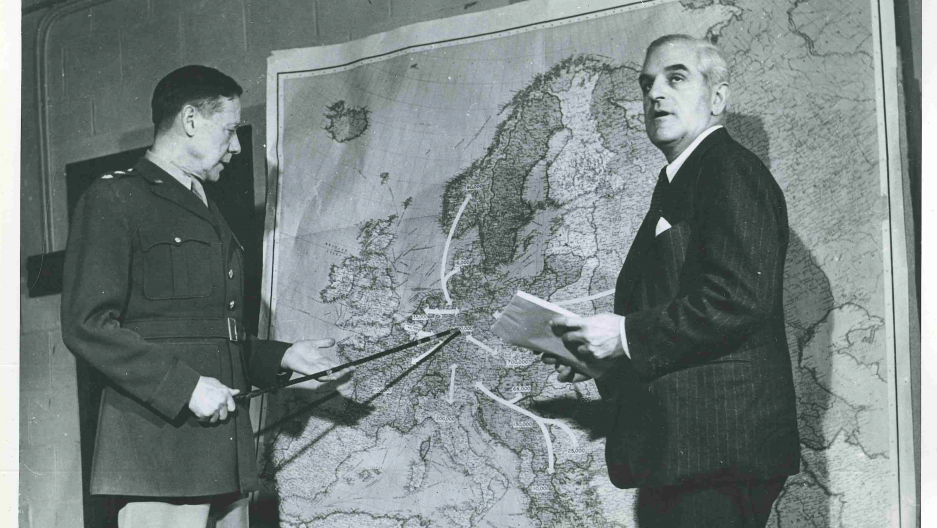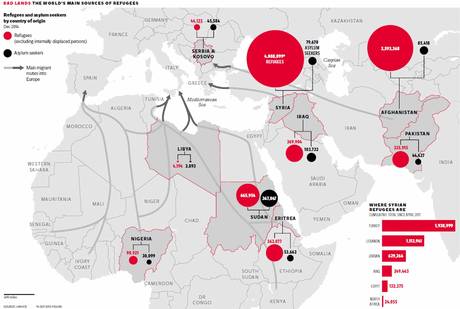During WWII European Refugees Fled to Syria – Here Is What the Camps Were Like
SPECIAL FEATURE, 30 May 2016
Evan Taparata and Kuang Keng Kuek Ser – Public Radio International-PRI

US Army General Allen Gullion and Fred K. Hoehler, Director of the United Nation’s Division of Displaced Persons, stand before a map predicting the movement of European refugees of World War II. Many Europeans would find a haven in refugee camps in the Middle East.
Credit: Courtesy of the Fred K. Hoehler Papers in the Social Welfare History Archives, University of Minnesota
Since civil war erupted in Syria five years ago, millions of refugees have sought safe harbor in Europe by land and by sea, through Turkey and across the Mediterranean.
Refugees crossed these same passageways 70 years ago. But they were not Syrians and they traveled in the opposite direction. At the height of World War II, the Middle East Relief and Refugee Administration (MERRA) operated camps in Syria, Egypt and Palestine where tens of thousands of people from across Europe sought refuge.
MERRA was part of a growing network of refugee camps around the world that were operated in a collaborative effort by national governments, military officials and domestic and international aid organizations. Social welfare groups including the International Migration Service, the Red Cross, the Near East Foundation and the Save the Children Fund all pitched in to help MERRA and, later, the United Nations to run the camps.
The archival record provides limited information on the demographics of World War II refugee camps in the Middle East. The information that is available, however, shows that camp officials expected the camps to shelter more refugees over time. Geographic information on location of camps come from records of the International Social Service, American Branch records, in the Social Welfare History Archives at the University of Minnesota.
In March 1944, officials who worked for MERRA and the International Migration Service (later called the International Social Service) issued reports on these refugee camps in an effort to improve living conditions there. The reports, which detail conditions that echo those faced by refugees today, offer a window into the daily lives of Europeans, largely from Bulgaria, Croatia, Greece, Turkey and Yugoslavia, who had to adjust to life inside refugee camps in the Middle East during World War II.
To continue reading the article please Go to Original – pri.org
DISCLAIMER: The statements, views and opinions expressed in pieces republished here are solely those of the authors and do not necessarily represent those of TMS. In accordance with title 17 U.S.C. section 107, this material is distributed without profit to those who have expressed a prior interest in receiving the included information for research and educational purposes. TMS has no affiliation whatsoever with the originator of this article nor is TMS endorsed or sponsored by the originator. “GO TO ORIGINAL” links are provided as a convenience to our readers and allow for verification of authenticity. However, as originating pages are often updated by their originating host sites, the versions posted may not match the versions our readers view when clicking the “GO TO ORIGINAL” links. This site contains copyrighted material the use of which has not always been specifically authorized by the copyright owner. We are making such material available in our efforts to advance understanding of environmental, political, human rights, economic, democracy, scientific, and social justice issues, etc. We believe this constitutes a ‘fair use’ of any such copyrighted material as provided for in section 107 of the US Copyright Law. In accordance with Title 17 U.S.C. Section 107, the material on this site is distributed without profit to those who have expressed a prior interest in receiving the included information for research and educational purposes. For more information go to: http://www.law.cornell.edu/uscode/17/107.shtml. If you wish to use copyrighted material from this site for purposes of your own that go beyond ‘fair use’, you must obtain permission from the copyright owner.
